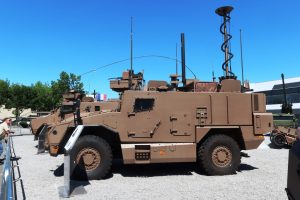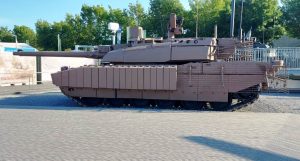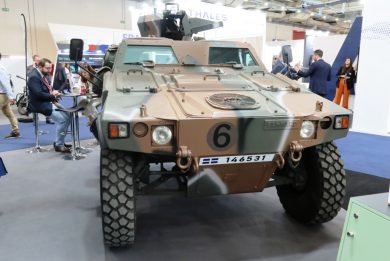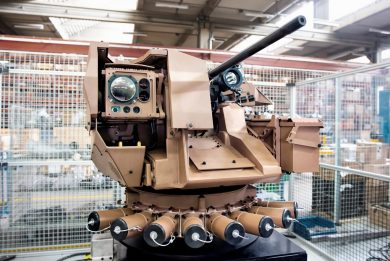
Reducing fuel consumption, reducing noise: the Arquus approach to hybrid propulsion
Its main customer being the French military, Arquus looks closely to its needs, and more specifically to those of the Army, the latter being the one that fields the grater number of vehicles of all types.
The Direction Générale de l’Armement (DGA), the French Government Defence procurement and technology agency, asked the company to developan operational hybrid Griffon vehicle, the choice falling on a Command Post version, as this is definitely among those that would benefit the most of such propulsion system not only in terms of fuel consumption reduction but also for the on-board power capacity allowing command systems to run on batteries with the engine shut.
Considering a standard mission downrange the French Army estimates a reduction of around 40% in fuel consumption. The DGA requirement is that the armoured hull must remain identical, as well as the 400 hp engine currently in use. This of courses raises a problem in terms of space, as the new powerplant cannot be bigger than the existing one. To cope with this constraint Arquus decided to replace the automatic transmission currently in use with a robotic transmission. The latter is a gearbox that works similarly to a manual one but with a higher number of gears, usually 12, shifting being made by an electric actuator, which differs from the automatic transmission where the friction clutch is replaced by fluid coupling and the system defines a set of gear ranges depending on the needs of the auto. The advantage of that change is a reduction in mass of around 30%, and the reduced volume also because a robotic transmission does not need a cooling system. Such a transmission was already used years ago when Arquus, then still Renault Trucks Défense, developed its VAB Electer technology demonstrator. The hybrid solution is however different. In the demonstrator the choice went for an ISAM (Internal Starter Alterno-Motor) a solution now considered obsolete, the Griffon being equipped with an external electric machine with a 200 kW peak power and a 140 kW continuous power.
The Griffon propulsion system will be a parallel hybrid, the electric machine being plugged into the intermediate crankshaft of the transmission. This allows to work in diesel only mode, electric only mode, electric power generation, and booster mode where both the electric and diesel provide energy for the movement, the electric one also adding its very high torque that provides high acceleration in critical tactical situations.
Although many might think that a hybrid solution adds weight, in fact this is not necessarily true. Currently the Griffon Command Post vehicle carries a six-battery lead pack weighing 240 kg, which in the hybrid version will be replaced by 2-3 Lithium-Ion batteries weighing 180 kg. The exact number of batteries will depend on the vehicle version and on its mission. Moreover, the CP version is currently fitted with a generator APU, which allows the command-and-control suite to operate for long periods even when the vehicle engine is switched off. In the hybrid version this will not be needed anymore, thanks to the considerable energy available on board, which brings to a saving of around 340 kg. The added weight is the 60 kg represented by the electric machine. In the end, the hybrid Griffon CP will have a similar if not lower weight.
According to Arquus the proposed solution will increase the vehicle endurance by 60%, will treble the autonomy with the engine cut, and will multiply by nine the power generation capacity, while reducing by 40% fuel consumption. Priority was given to the Command Post version, however in perspective all Griffons fitted with an APU on board should be equipped with the hybrid powerpack, the other ones being the Engineer vehicle and the Artillery Forward Observer one. A contract for the Griffon CP demonstrator is awaited soon, possibly in June 2022. How much the development of a hybrid solution will also have an impact on the Jaguar 6×6 recce vehicle is to be seen.
In terms of hybridisation both the French Army and Arquus are looking not only at the recently introduced 6×6 armoured vehicle, the Leclerc main battle tank and the VBCI 8×8 infantry fighting vehicle being also part of the R&D work. For the MBT Arquus estimates that consumption will be reduced by 65%, endurance as well as stocked energy on board will be trebled, while energy production will be multiplied by 7.6. Hybridisation will also have a beneficial effect on logistics; currently the MBT fuel tank must be emptied and cleaned every 200 hours, a tank in OOTW operation running for around 1,000 hours per year. Each fuel tank cleaning takes around three days and puts considerable pressure on maintainers. The adoption of the hybrid powerpack would allow reducing this operation to only one per year, and consequently the logistic strain.
The current Leclerc upgrade that falls within the Scorpion programme does not foresee the adoption of a new powerpack, this option being part of a second tranche upgrade, which is also linked to the evolution of the MGCS (Main Ground Combat System) programme, the future MBT and high-end combat solution currently developed jointly by France and Germany. That said the study project on the Leclerc should be completed by August 2022, and a demonstrator should be produced in the near future.
This will of course be beneficial also to the MGCS programme, as the new MBT should definitely adopt some innovative propulsion solution. What will it look like is still uncertain, as according to available information Germany tends to consider a 70 tonnes tank armed with a 130/140 mm gun, while France favours a much lighter solution, around 46 tonnes.
Another vehicle in service with the French Armée de Terre will soon need to undergo an upgrade, the first VBCI 8×8 reaching 15 years of in-service life. Here the problem is someway more difficult to be solved, the current engine being now obsolete, while the transmission is also reaching obsolescence. French Army requirements include an increased on-board power allowing adding new subsystems, an increased payload, all this at equal mass and maintaining the engine and transmission. Currently French Army vehicles are powered by a 12 litres engine while export ones are fitted with a 13 litres one. Arquus is proposing the same solution adopted for the Griffon, with a Jaguar 11 litres engine providing 500-550 hp, and the same robotic transmission and electric machine, such a solution also ensuring full logistic commonality. Benefits will be similar to those of the Griffon, with the exception of power generation capacity that will be multiplied by 18, as the VBCI is currently fitted with a 300 Ah Alternator, the Griffon being equipped with a 600 Ah one. No roadmap seems to be currently established for a VBCI powerpack upgrade.
In 2020 Florence Parly, then French Minister of the Armed Forces, announced a programme aimed at moving military energy consumption towards a green approach. Hydrogen was obviously one of the key elements of her speech. While solutions based on the H2 can be foreseen for static applications, exploiting hydrogen as fuel for combat vehicles is another story. This does not mean that studies are not carrying out, and Arquus is engaged in an R&D programme that considers the use of that gas on board vehicles.
The use of hydrogen is not easy, especially on combat vehicles. From the logistic standpoint H2 is five times heavier and occupies five times the volume for providing the same energy of current fuels, moreover it must be stocked at 700 bar pressure, and in a safe way. Arquus is considering as a solution an engine that can work both with hydrogen and kerosene. When deployed in operation it would run 100% on kerosene, so the logistic fuel supply chain would remain the same, while when used in country it would run on a kerosene/hydrogen mix, which is much cleaner than a kerosene-only engine, albeit not as clean as a hydrogen cell. Such an engine would have around 20% more mechanical pieces compared to an equivalent kerosene engine. In this R&D programme Arquus exploits the research work carried out by the Volvo Group.
Photos courtesy Arquus and P. Valpolini





